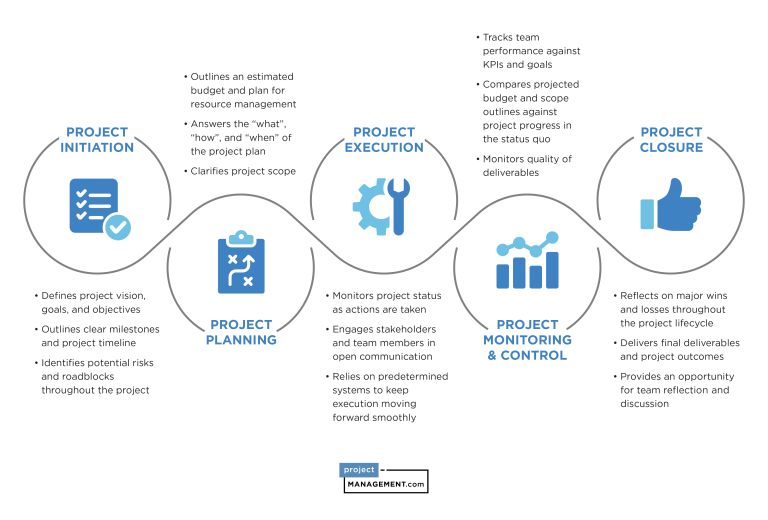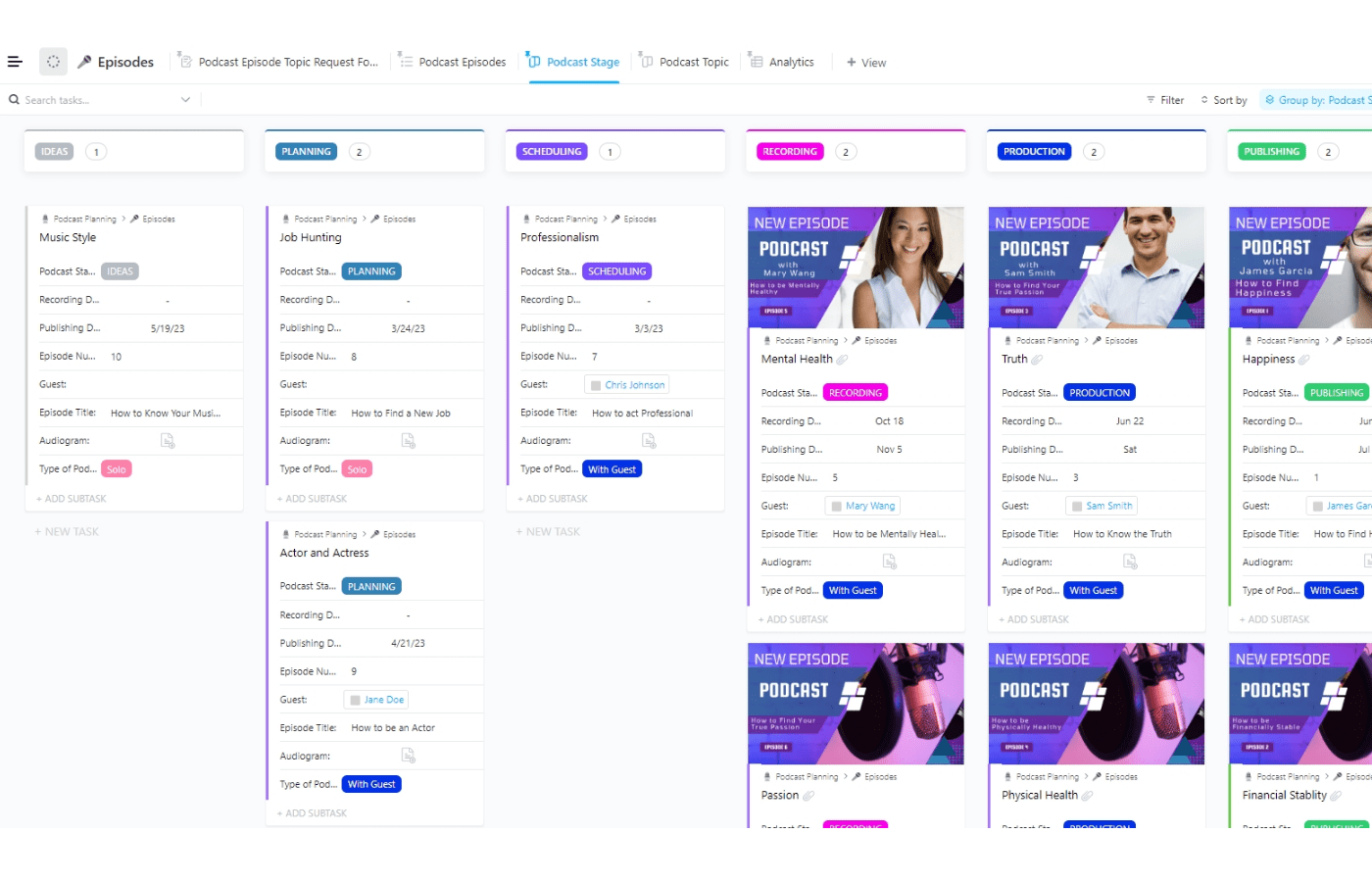In today’s fast-paced business world, mastering project management is more complex and demanding than ever before. As organizations juggle multiple projects, project managers must possess a wide range of skills, from leadership and communication to risk assessment and technical proficiency. These essential tips will help you thrive in this evolving landscape and move forward in your project management career path.
Key takeaways
How to Become a Good Project Manager
The key to becoming a successful project manager is understanding that there is no one-size-fits-all approach. Each project presents its own unique challenges, and a good project manager knows how to adapt and apply the right strategies at the right time. Whether it’s keeping communication lines open, managing risks, or balancing methodologies, these 10 project management tips will provide a foundation for excelling in a project management career.

Tip #1: Communicate Effective Strategies
At the heart of any successful project lies clear and effective communication. As a project manager, your role involves constantly interacting with team members, stakeholders, and upper management. Communication breakdowns can lead to misunderstandings, missed deadlines, and even project failure. Here are some key strategies for fostering effective communication:
Set clear expectations: From the outset of the project, ensure that every team member understands their role, the project goals, and the expected timelines. This minimizes confusion and keeps everyone aligned.
Use collaboration tools: In the age of digital workspaces, tools like Slack, Microsoft Teams, and Asana can streamline communication. These tools allow for real-time updates, shared document access, and task tracking.
Hold regular meetings: Consistent meetings, whether daily standups or weekly reviews, help teams stay on track and address issues as they arise.
Practice active listening: It’s not just about talking — project managers must be good listeners. Pay attention to feedback, concerns, and suggestions from your team to ensure their voices are heard.
Be transparent: Keep stakeholders and team members in the loop about progress, potential setbacks, and any changes to the project plan. Transparency builds trust and keeps everyone engaged.
Clear and effective communication is one of the top project management tips you should follow for better collaboration and project success.
Tip #2: Prioritize Tasks and Manage Time
A project manager’s ability to prioritize tasks and manage time effectively can make or break a project. With multiple tasks and limited resources, it becomes an essential project management practice to identify what needs immediate attention and what can be deferred.
Use project management tools: Software like Trello, ClickUp, or Jira allows you to create task lists, assign deadlines, and track progress. These tools provide a clear overview of project timelines and priorities.
Time-blocking: Allocate specific blocks of time to work on tasks, ensuring that high-priority tasks receive the focus they need. This also helps prevent multitasking, which can reduce efficiency.
Delegate tasks: Learn to delegate responsibilities to team members based on their strengths. Effective delegation not only lightens your load but also empowers your team to take ownership of tasks.
Stay adaptable: Even the best-laid plans can go awry. Be ready to reassess priorities as new information or changes arise during the project.
Effective time management ensures that deadlines are met and that your team can maintain a steady pace throughout the project’s lifecycle.
READ MORE: How to Create a Project Management Plan in 5 Steps + Key Tips
Tip #3: Manage Risks During Project Planning
No project is without risks, but the key to success lies in your ability to identify, assess, and mitigate those risks. Implementing this project management tip can help you effectively manage risks and prepare for unforeseen challenges.
Identify risks early: Start by identifying potential risks during the planning phase. These could include anything from budget constraints and timeline issues to resource shortages and technical challenges.
Conduct a SWOT analysis: SWOT (Strengths, Weaknesses, Opportunities, Threats) analysis can help you evaluate both internal and external factors that could impact the project.
Create a contingency plan: Once risks are identified, develop strategies for mitigating them. This might involve allocating extra resources, adjusting timelines, or preparing backup solutions.
Monitor risks throughout the project: Risk management isn’t a one-time task. Continue to assess risks as the project progresses and adjust your plan accordingly.
By proactively addressing potential risks, you can reduce their impact and keep the project on track.
Tip #4: Involve Stakeholders Throughout the Project
Stakeholders play a critical role in the success of any project. Their buy-in and feedback are essential for ensuring that the project meets its goals and delivers value. Managing stakeholder involvement effectively can prevent misunderstandings and ensure alignment with project objectives.
Maintain regular communication: Schedule regular updates with stakeholders to keep them informed of progress, roadblocks, and any changes to the project. This helps manage expectations and keeps everyone on the same page.
Involve stakeholders in key milestones: Ensure that all types of stakeholders are engaged during critical phases of the project, such as project kickoff, mid-point reviews, and final delivery.
Balance stakeholder needs with project goals: While stakeholder feedback is important, it’s essential to ensure that their needs don’t derail the project. Find a balance between their expectations and the project’s objectives.
Build strong relationships: Establishing trust with stakeholders will make them more receptive to your decisions and more supportive of the project as a whole.
READ MORE: What Is Stakeholder Analysis?
Tip #5: Balance Agile and Traditional Project Management Methods
In today’s dynamic work environment, it’s often necessary to blend agile project management and the traditional waterfall model. Each approach has its strengths, and knowing when to use each can enhance project outcomes.
Agile for flexibility: Agile methodologies, such as Scrum, are best suited for projects that require frequent iterations and are subject to changing requirements. Agile encourages collaboration, adaptability, and incremental progress.
Waterfall for structure: Traditional waterfall methods are ideal for projects with well-defined stages and where changes are minimal once the project begins. It provides a structured, sequential approach.
Hybrid approaches: Some projects benefit from a hybrid model, where agile is used for specific aspects, such as development, while waterfall is employed for planning and documentation.
Assess the project requirements: Choose the methodology based on the project’s complexity, timeline, and client requirements.
Mastering both methodologies is one of the best project management tips that will allow you to tailor your approach to the project’s needs, leading to greater success.
READ MORE: How to Be More Efficient in Your Project Management
Tip #6: Learn from Project Failures
Not every project will be a resounding success. However, project failures can provide valuable lessons that improve future projects.
Conduct post-project reviews: After completing a project, gather your team to analyze what went wrong and what could have been done differently. This reflection helps identify areas for improvement.
Build a culture of continuous improvement: Encourage your team to see failures as opportunities for growth. Create an environment where feedback is welcomed and lessons from mistakes are shared.
Document learnings: Keep a record of challenges faced and solutions found during the project. This documentation can serve as a reference for future projects.
Failure is inevitable, but how you respond to it will determine your growth as a project manager and is one of the most valuable project management tips you can use for success.
Tip #7: Continue to Learn and Stay Up to Date with Industry Trends
Project management is dynamic. As technologies advance and industries change, one of the most important project manager tips is to stay up to date with new trends, project management concepts, tools, and methodologies.
Attend industry conferences: Conferences and seminars provide opportunities to learn from experts and stay informed about the latest developments in project management.
Earn certifications: Certifications like PMP, agile, or Scrum Master can enhance your skills and demonstrate your expertise.
Leverage emerging technologies: Stay informed about tools like AI, machine learning, and automation that can streamline project management processes.
Join professional communities: Engage with online forums, LinkedIn groups, or local meetups to share knowledge and learn from others in the field.
Continuous learning will ensure that you remain competitive and well-equipped to handle the complexities of modern project management.
Tip #8: Manage Stress Effectively
Project manager is a high-pressure role, with tight deadlines, multiple responsibilities, and constant decision-making. Managing stress effectively is essential for maintaining your well-being and the health of the project.
Delegate tasks: Don’t try to do everything yourself. Delegate tasks to team members to distribute the workload and reduce stress.
Practice mindfulness: Mindfulness techniques, such as meditation or deep breathing exercises, can help you stay calm and focused under pressure.
Maintain a work-life balance: Ensure you take breaks and set boundaries between work and personal time. Overworking can lead to burnout, which negatively impacts both your health and the project.
Seek support: Don’t hesitate to seek help from mentors, colleagues, or stress management resources when needed.
Managing stress not only benefits you but also sets a positive example for your team.
Tip #9: Navigate Remote and Hybrid Work Environments
With the rise of remote and hybrid work environments, project managers face new challenges in team management and communication. Managing a distributed team requires different strategies to maintain engagement and productivity.
Use robust collaboration tools: Tools like Zoom, Microsoft Teams, and Trello are essential for facilitating communication and collaboration among remote teams.
Foster team engagement: Keep team members engaged by encouraging regular communication, video meetings, and virtual team-building activities.
Maintain transparency: Ensure all team members, whether remote or in-office, have access to the same information and updates.
Adapt to time zones: For global teams, be mindful of time zone differences when scheduling meetings and setting deadlines.
Remote project management requires flexibility and the ability to foster collaboration, even when team members aren’t physically present. Embracing digital tools and maintaining consistent communication will keep the project on track.
Tip #10: Leverage Emerging Technologies Like Artificial Intelligence
As technology continues to advance, project managers can leverage AI to improve project outcomes and streamline processes. AI in project management can assist with decision-making, automate repetitive tasks, and provide valuable data insights.
Automate routine tasks: Use AI tools to handle repetitive tasks such as scheduling, data entry, or reporting. This frees up time for more strategic work.
Improve project forecasting: AI tools can analyze past project data to provide more accurate forecasts and predict potential risks or delays.
Enhance decision-making: AI can assist in analyzing data and offering recommendations based on real-time information, enabling faster and more informed decisions.
Embracing AI technologies is one of the most effective project management tips to enhance efficiency and drive better project outcomes.
FAQs
Bottom Line
Project management is a complex and ever-evolving field, but by applying these 10 tips, you can set yourself up for long-term success. Whether it’s mastering communication, managing risks, or leveraging AI technologies, these strategies will help you lead your projects with confidence and achieve your goals. Embrace continuous learning and improvement, and remember that even failures can be valuable stepping stones toward growth.
By applying these project management tips, you’ll be better equipped to lead projects to success, regardless of the challenges you face.





